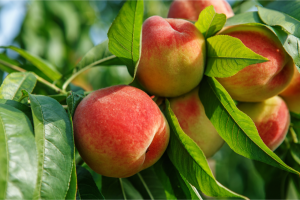Researchers are trialling new sensor technology with local fruit growers to reveal how ripe and sweet the fruit is without even taking a bite.
The $1.1 million Sensors for Summerfruit project launched this week by the Food Agility Cooperative Research Centre (CRC) will be led by Agriculture Victoria in collaboration with RMIT University, Summerfruit Australia and local technology firms Green Atlas and Rubens Technologies.
The three types of sensor technologies being developed and tested as part of the project will measure the sweetness of summer fruits from peaches to nectarines, plums or apricots, as well as monitoring their ripeness, size and signs of disease or pests.
Food Agility CRC Chief Scientist, Professor David Lamb, said the ultimate goal of the 2½ year project is to help growers get the right piece of fruit to the right consumer at the right time.
“From orchard to export, data-driven decisions are key. Two of the sensors, RMIT’s Bistatic LiDAR and Green Atlas’ Cartographer, will operate in the orchard helping to assess health status and predict fruit size, yield and maturity,” Lamb said.
“A third sensor, Rubens’ Fluorescent Spectrometer, will be put to work in the packing sheds to detect sweetness, firmness and robustness for transport. It’s the closest thing to tasting the fruit, without actually taking a bite.”
Road-tests in commercial orchards
The sensors will be calibrated on Agriculture Victoria’s Tatura SmartFarm in Goulburn Valley, and then road-tested in commercial orchards and packhouses in Goulburn Valley, Swan Hill, Cobram, and Sunraysia.
Chair of the RMIT's Cyber-Physical and Autonomous Systems Group, Professor Roberto Sabatini, said the project presented an exciting opportunity to demonstrate that the remote sensing and early diagnosis technologies they'd developed were cost-effective, impactful and scalable both within and beyond the agriculture industry.
"Cyber-physical systems, sensor networks and data fusion technologies are increasingly relying on artificial intelligence to maximise business performance, profitability and sustainability in all sectors driving the digital transformation here in Australia and globally.”
Research Leader Crop Physiology at Agriculture Victoria Dr Ian Goodwin said the project aimed to benefit the Summerfruit sector by growing export markets and improving their operations.
Growing fruit consumers want
“Fruit is downgraded or redirected at the harvesting and packing stages because it doesn’t meet consumer preferences for that market or, if fruit is harvested too early or too late, the quality can deteriorate in transit,” Goodwin said.
“Using these sensors, we could help growers tailor their practices to grow the fruit consumers want, triaging fruit in the packing sheds, and only exporting those robust enough to make the journey.”
Summerfruit Australia Ltd CEO Trevor Ranford said the project would focus on the Chinese market but would ultimately be relevant to any export market for Australian stone fruit.
“We have spent years improving our understanding of consumer preferences,” said Ranford.
“For example, when it comes to nectarines, our Chinese consumers prefer yellow nectarines that are sweet and low in acid, with a redder skin colour.”
This depth of consumer understanding has seen Australian Summerfruit exports increase annually by an average 12 per cent for the last 10 years.
“In the 2019-20 season alone the industry exported over 21,000 tonnes of stone fruit worth $89.11 million,” he said.
“This project takes it to the next level, helping us refine those requirements and make decisions along the supply chain to grow high-quality fruit that looks, tastes and feels perfect to Chinese consumers and consumers in more than 40 other export markets.”


